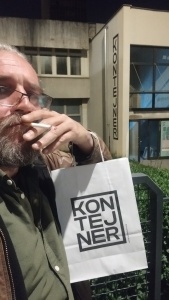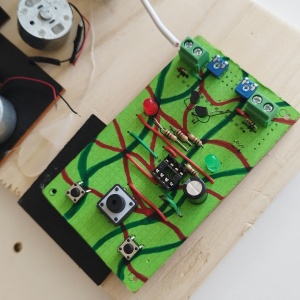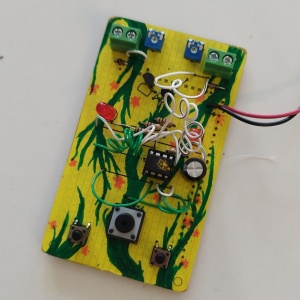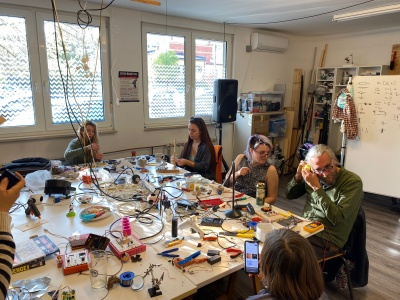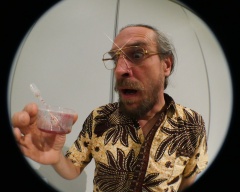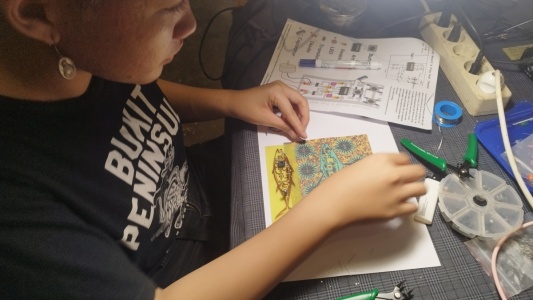Dusjagr's Radiona Residency 2024
Contents
Residenzli Photos
Hanging out
Workshop impressions
Workshop: "RnB"
20 & 21 March 2024, 18:00 - 21:00
RnB - Record n Beyond is a make-listen-create workshop involving a simple electronic circuit that we will build together, to control and program two individual motors, which can be used to create kinetic sound sculptures. During the workshop the participants will be introduced into the basics of soldering and electronic components using the very accessible method of "paper-bits". The circuit allows the user to record and play/loop patterns of "beats" which then make the motors move, wiggle, twist, flip various objects that can be crafted into a kinetic sound machine. Together with the whole group of participants we will construct a room filling sound sculpture, using found objects and recycled materials, to explore different noises and materialities collaboratively.
This workshop has been inspired by Ralf Schreiber (DE) who describes it as follows:
"A workshop where participants will build small electro-mechanical solo drum machines from single DC motors and small circuit boards. The workshop will experiment with different kinds of sounding materials (metal pieces, stones, springs, paper, etc), where the machines will oscillate freely and develop their own individual sound quality. Once built the machines will be used to explore fundamental musical structures."
- No previous knowledge in electronics is necessary
- Bring interesting materials to experiment with from home
- Guest input lecture: Helmi Hardian is a grassroots artist and ghetto scientist, with a specific interest in cooking and smoking at the same time. He lives in Surabaya, the city that is well known for its industry and technology, as well as being the center of electronic component trading. He focuses on tech development through DIY/DIWO culture and playing his role in researching, hacking, or deconstructing daily materials to provide some devices with new functional aspects, as well as developing workshop kits, lecturing contents, and presentation materials, which aim to learn, share, and exchange knowledge
Paper PCB version developed in Thailand, Jan 2024

Paper PCBs is the fastest and the most flexible rapid prototyping system developed by Wolfgang Spahn since the early 2K. Paper PCBs are Printed Circuit Boards (PCB) based on paper print outs combined with copper strip boards, also called Veroboards. With these boards one can easily build and modifier real electronic circuits that could be used in any devices and applications.
For all kind of media installation based on controller and electronics one requires printed circuit boards (PCB's). It can be quite a task to get the perfect one that matches your needs. Due to industrial standards it takes some time and money to get them manufactured. Another option is to create them by yourself, but most likely you'll end up with a lot of dangerous chemicals and find yourself drilling hundreds of holes.
Paperboards or Paper PCBs are a smart way to avoid the trouble. It is an open hardware system that allows you to create PCB's easily. You simply need a drawing program like Gimp, Inkscape or (Photoshop) to design or modify them on your computer (Fritzing will also do). Just print it and stick the printed circuit on a standard protoboard (available at every electronic shop) and voilà - there is your proper PCB. The system allows you to get an individual colorful design, too.
How to make sound?
Wenn du ohne Gravitation schlagen willst, kannst du die Motoren ja noch mit ner Bronzefeder (30x2x0,1mm) modden. 0,1mm dicke Bronzebleche solltest du finden können. Lüsterklemme auf Motorachse schrauben, Enden der Feder an Klemme & direkt ans Motorgehäuse löten...fertig.
Interessant wird es auch mit beidseitig elastischen Anschlägen (Bronzebleche)....oder den Schlegel mit Silikonschlauchstückchen/kleinen Federn bestücken. Da bekommst du Doppelschläge / mechanisches Delays...
Testing to build the circuit on proto-board, and doing the mechanical spring with cable ties. seems to work ok... the circuit is a bit complicated to build like this for beginners...
Background
"A workshop where participants will build small electro-mechanical solo drum machines from single DC motors and small circuit boards. The workshop will experiment with different kinds of sounding materials (metal pieces, stones, springs, paper, etc), where the machines will oscillate freely and develop their own individual sound quality. Once built the machines will be used to explore fundamental musical structures." - from Ralf Schreiber
As always, Ralf's workshops are fantastic examples combining technological simplicity, DIY electronics & soldering with a broad artistic and aesthetic creative potential for collaborative sound / kinetic art-making to explore together with workshop participants of all age groups and backgrounds.
During the TUAK residensi, we have picked up on of Ralf's workshop, the Record & Play, and experimented with different models for using it as a local workshop module in Indonesia. During the conversations with Ralf, we also found the new code, developed my ChrisMicro which allows to control 2 motors with a single ATTINY85 chip, using classes and object oriented code.
Mentors
Marc Dusseiller aka dusjagr (Switzerland)
Marc Dusseiller aka dusjagr is a nomadic researcher and workshopologist. He is part of the Center for Alternative Coconut Research, co-founder of SGMK, Bitwäscherei Hackerspace Collective and the Hackteria network. Before travelling the world for making DIY / DIWO laboratories for creative biological experimentation with living media, Marc entered the world of DIY electronics, designing printed circuit boards for synthesizers and organizing workshops and festivals mostly in Zürich, Taipei and Yogyakarta. He was the co-organizer of the different editions of HackteriaLab 2010 - 2020 Zürich, Romainmotier, Bangalore, Yogyakarta and Klöntal, Okinawa and collaborated on the organisation of the BioFabbing Convergence, 2017, in Geneva and the Gathering for Open Science Hardware, GOSH! 2016, Geneva & 2018, in Shenzhen. He also loves coconuts.
Remote Observers and Collaborators
Helmi Hardian (Surabaya, Indonesia) | BIR residensi
Helmi Hardian is a grassroots artist and ghetto scientist, with a specific interest in cooking and smoking at the same time. He lives in Surabaya, the city that is well known for its industry and technology, as well as being the center of electronic component trading (chiefly, Pasar Genteng). Hence, almost all of his works are closely related to science and technology as the medium of creativity. He is the co-founder of Waft Lab, a creative-based initiative that works at interdisciplinary practices. Currently, he focuses on tech development through DIY/DIWO culture and playing his role in researching, hacking, or deconstructing daily materials to provide some devices with new functional aspects, as well as developing workshop kits, lecturing contents, and presentation materials, which aim to learn, share, and exchange knowledge.
- https://waft-lab.com/
- https://www.instagram.com/helmihardian/
- https://www.hackteria.org/workshops/pasar-senggol/
More inspriational examples
Earlier test runs of the workshop
Workshop "Simple Kinetic Sound Sculpture" at Pazar Kaget, GOR, Bandung
Dusjagr was invited to visit GOR (Gelanggang Olah Rasa), in Bandung, and participate with a DIY electronics & art workshop during their weekend Bazaar. We took the opportunity to try out the new workshop concept adapted during the TUAK residensi, where we redesigned new PCBs for the workshop "record & play" by Ralf Schreiber.
Workshop "Simple Kinetic Sound Sculpture" at FKSM - Festival Komunitas Seni Media, Lombok, Indonesia
june 2023
"ultra-mega terlambat posting, tampak suasana lokakarya @fksm.indonesia merangkai pengontrol motor dc untuk kebutuhan ini dan itu. lokakarya ini diadakan oleh kemendikbudristek dan @arcolabs.id di taman budaya mataram ntb, kala itu sekitar awal juni 2023. konversi desain menggunakan inkscape extension svg2shenzhen bikinan badgeek @manticore_ , sayangnya nggak sempat order ke shenzhen, akhirnya balik ke manual lagi XeroX dan aut666n tak lupa pcb bolong. kami dari @waftlab mengucapkan yaey"
Residency research topics
19. - 27. March
I am super happy to spend some days in Radiona to work on a few of my ongoing research interests!
Workshopology Zine / Playbook for Record and Play DUA
During 2022 and 2023, I have been motivated to continue my workshopology interests and I had the chance to work in diverse environments, from Maribor to Surabaya, Zurich to Chiang Mai, with a highly skilled group of other workshop enthusiasts. I have been following the idea to reproduce each others workshop concepts, fork and modify the methods, readapt them to different local environments and keep a group discussion alive to compare and reflect on each others experiences. An example, described below, is when I reproduced the workshop by Arnont Nongyao, who I met in Yogyakarta and participated at his workshop GBMN, in different locations, and then collaborated with him on making a zine together. Instead of a mere "instruction" we aimed at a different content of our so called "playbook", focusing more on stories and reflections mixed up with beautiful illustrations, acompaning the basics like material lists and step-by-step. The zine should inspire other workshop enthusiasts to try out such a workshop and keep in mind the larger context of why we are doing them.
Revised GBMN Zine / playbook, English


Reflecting on those GBMN workshops after experiencing it first time in Yogya and then dusjagr's "reproduction" of the method in Maribor. Marc Dusseiller, Arnont Nongyao, Monika Pocrnjić.
https://mega.hackteria.org/index.php/s/6esFrkW3aDkJCTZ
Revised and summarized by chatGPT
In this transcendent dialogue, Marc, Arnont, and Monika engage in a profound exploration of the workshopology realm. Inspired by Arnont's "GBMN - gentle but make noise" workshop, Marc attempted to recreate its essence in Maribor. Monika reflects on the workshop's enigmatic nature, characterized by self-organization and a departure from traditional mentorship dynamics. Arnont shares his journey, learning electronics through his mentor's unorthodox approach and embracing the beauty of simplicity.
The significance of crafting materials emerges as a central theme, with Arnont emphasizing the importance of locality and personalization. Monika highlights the rarity of individual expression in traditional electronics workshops, while Marc contemplates the workshop's unique start with painting and drawing before delving into electronics. The method's resonance with old-fashioned three-dimensional craftsmanship, reminiscent of a bygone era, captivates Arnont.
In their closing reflections, Marc, Monika, and Arnont share personal anecdotes, illustrating their journeys in the realm of electronics. Marc's background in material science and engineering led him to embrace simple electronics for over a decade. Monika's fascination with disassembling objects propelled her towards arts education and a lasting passion for electronics. Arnont's teenage exposure to electronics and his pursuit of simplicity shaped his artistic path. Through their profound exchange, they cultivate a deeper understanding of the workshop's transformative power.
Software development for Pd BioAmp
I have been teaching a project based learning class (Medizintechnik DIY) in the FabLab Luzern for the last couple of years, where we explore various tools of digital fabrication, arduino, in the context of medical technologies, using simple open hardware amplifiers to measure voltages produced in the human body (EMG, ECG, EOG, EEG). That includes muscle contraction, heart beat, eye movement, or slighly more challenging also brain waves.
Due to the fact that we still have many of those BioAmps in stock (and the class has been cancelled), I have been working on a more robust and complete prototype -> product to share the device for other interested geeks worldwide. Unlike in the class, the Pd BioAmp is more towards giving a functional / finished product to musicians & artists to explore how to integrate it in their own works.
For this I want to use the time during the residency to further develop the software and hopefully get feedback / help from other members of Radiona.
PCB design for Eurorack Bioamp
I produced already 3 prototypes that are assembled in a more robust format with a nice box and frontplate. Because I want to share the devices with a larger group of musicians, and making them all by hand is a bit too much, it's time to design a PCB that can be produced, assembled and will fit into the standard Eurorack format for people to add to their existing setup.




